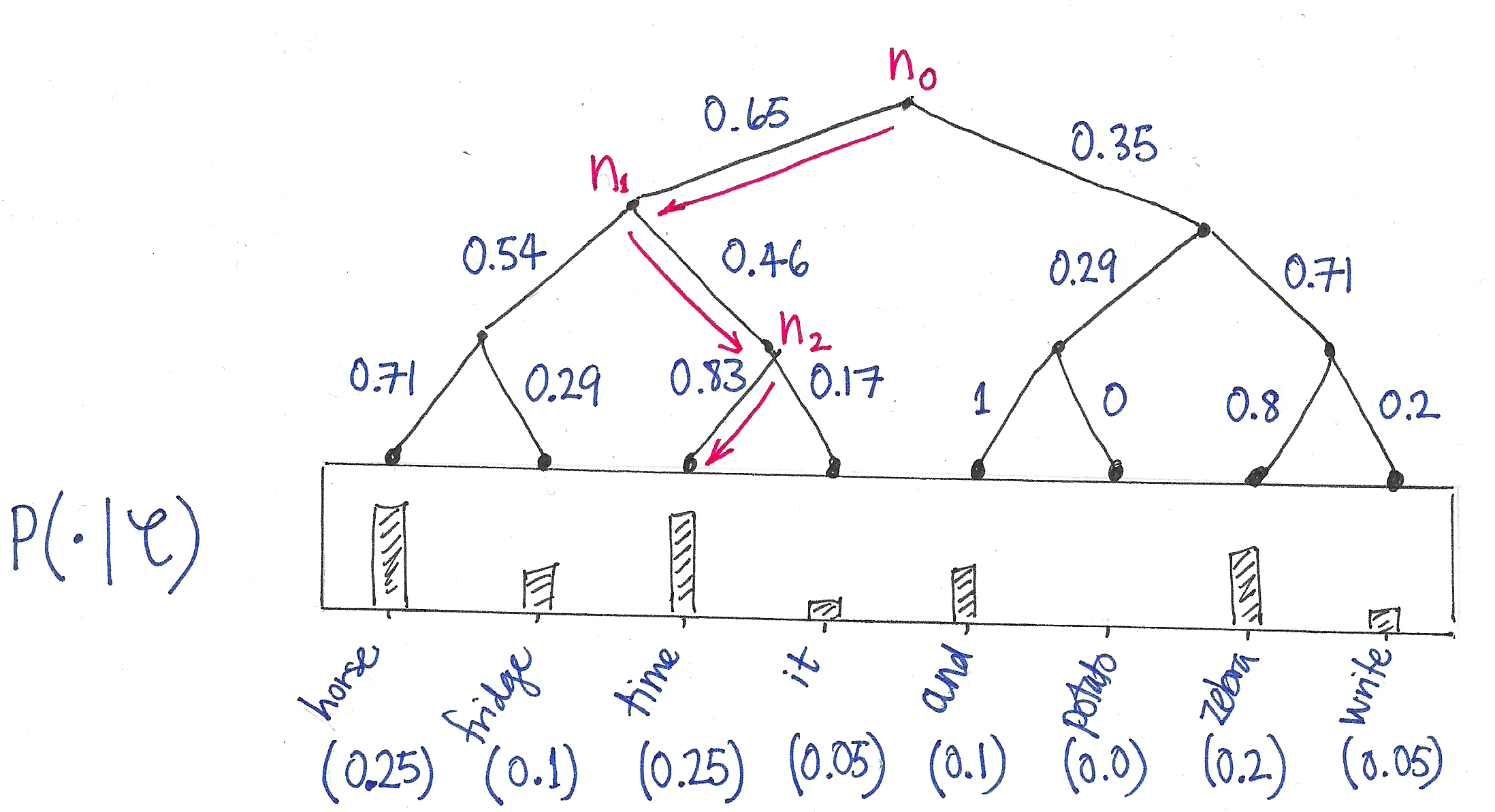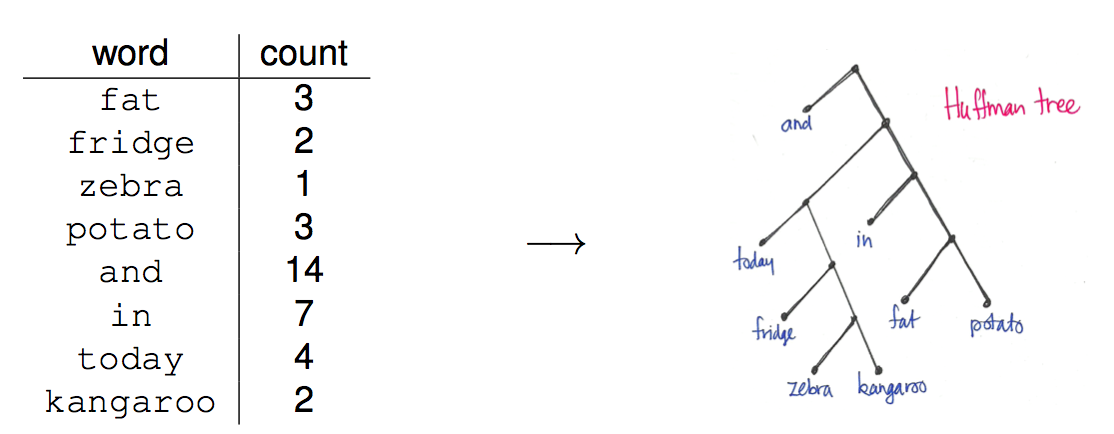[These are the notes from a talk I gave at the seminar]
Hierarchical softmax is an alternative to the softmax in which the probability of any one outcome depends on a number of model parameters that is only logarithmic in the total number of outcomes. In “vanilla” softmax, on the other hand, the number of such parameters is linear in the number of total number of outcomes. In a case where there are many outcomes (e.g. in language modelling) this can be a huge difference. The consequence is that models using hierarchical softmax are significantly faster to train with stochastic gradient descent, since only the parameters upon which the current training example depend need to be updated, and less updates means we can move on to the next training example sooner. At evaluation time, hierarchical softmax models allow faster calculation of individual outcomes, again because they depend on less parameters (and because the calculation using the parameters is just as straightforward as in the softmax case). So hierarchical softmax is very interesting from a computational point-of-view. By explaining it here, I hope to convince you that it is also interesting conceptually. To keep things concrete, I’ll illustrate using the CBOW learning task from word2vec (and fasttext, and others).
The CBOW learning task
The CBOW learning task is to predict a word

We are interested then in the conditional distribution

This is very similar to language modelling, where the task is to predict the next word by the words that precede it.
CBOW with softmax
One approach is to model the conditional distribution
where
The parameters of this model are the entries of the matrices
Cross-entropy
For a single training example

Because
$$ H(y, \hat{y}) := – \sum_{w \in W} {y_w \log \hat{y}_w = – \log P(w_0|C).$$
Note that this expression doesn’t depend on whether
Optimisation of softmax
The above expression for the cross entropy is very simple. However, in the case of the softmax, it depends on a huge number of model parameters. It does not depend on many entries of the matrix
Hierarchical softmax
Hierarchical softmax provides an alternative model for the conditional distributions

Now view this tree as a decision process, or a random walk, that begins at the root of the tree and descents towards the leaf nodes at each step. It turns out that the probability of each outcome in the original distribution uniquely determines the transition probabilities of this random walk. At every internal node of the tree, the transition probabilities to the children are given by the proportions of total probability mass in the subtree of its left- vs its right- child:

This decision tree now allows us to view each outcome (i.e. word in the vocabulary) as the result of a sequence of binary decisions. For example:
where
These distributions are then modelled using the logistic sigmoid
where for each internal node
Which tree?
J. Goodman (2001)
Goodman (2001) uses 2- and 3-level trees to speed up the training of a conditional maximum entropy model which seems to resemble a softmax model without a hidden layer (I don’t understand the optimisation method, however, which is called generalised iterative scaling). In any case, the internal nodes of the tree represent “word classes” which are derived in a data driven way (which is apparently elaborated in the reference [9] of the same author, which is behind a paywall).
F. Morin & Y. Bengio (2005)
Morin and Bengio (2005) build a tree by beginning with the “is-a” relationships for WordNet. They make it a graph of words (instead of word-senses), by employing a heuristicFelix, and make it acyclic by hand). Finally, to make the tree binary, the authors repeatedly cluster the child nodes using columns of a tf-idf matrix.
A. Mnih & G. Hinton (2009)
Mnih & Hinto (2009) use a boot-strapping method to construct binary trees. Firstly they train their language model using a random tree, and afterwards calculate the average context vector for every word in the vocabulary. They then recursively partition these context vectors, each time fitting a Gaussian mixture model with 2 spherical components. After fitting the GMM, the words are associated to the components, and this defines to which subtree (left or right) a word belongs. This is done in a few different ways. The simplest is to associate the word to the component that gives the word vector the highest probability (“ADAPTIVE”); another is splitting the words between the two components, so that the resulting tree is balanced (“BALANCED”). They consider also a version of “adaptive” in which words that were in a middle band between the two components are placed in both subtrees (“ADAPTIVE(e)”), which results not in a tree, but a directed acyclic graph. All these alternatives they compare to trees with random associations between leaves and words, measuring the performance of the resulting language models using the perplexity. As might be expected, their semantically constructed trees outperform the random tree. Remarkably, some of the DAG models perform better than the softmax!
Mikolov et al. (2013)
The approaches above all use trees that are semantically informed. Mikolov et al, in their 2013 word2vec papers, choose to use a Huffman tree. This minimises the expected path length from root to leaf, thereby minimising the expected number of parameter updates per training task. Here is an example of the Huffman tree constructed from a word frequency distribution:

What is interesting about this approach is that the tree is random from a semantic point of view.

Hi,
Great Tutorial.Can you please explain how did you calculate transition probability like 0.65 and 0.35 at the root node ?
Hi! Sure can. The probabilities at the leaf nodes are determined by your probability distribution. The probabilities at any parent node are obtained by summing up the probabilities of the leaf nodes that can be reached by going left vs going right and then normalising so that the probabilities of going left and going right sum to one. For the root node: the leaves reached by proceeding in one direction give a total probability of 0.65, and in the other we get 0.35, and in this case there is no normalisation to be done since 0.65 + 0.35 already sums to one. I hope that helps!
Did you mix up P(right|C) and P(left|C) in P(“time”|C)?
Hi William, I am imagining myself walking down the tree (and facing down as I do it), so I think the sequence is correct! I should probably clarify that in the exposition, however, thanks for the tip!
Very nice review.
Really helps understanding the idea.
Thanks!
That was excellent. Thank you.
Hi Benjamin,
I’ve really enjoyed your article! So is hierarchial softmax like a computing softmax([sum(left_subtree_children), sum(right_subtree_children)]) for every node?
Hi Benjamin:
I notice that all of your nodes are positive. What if some of the values are negative? Negative values will not hurt softmax for it goes through exp. How will this model respond to it?
Hi, I would like to know how you calculate the probabilities of the leaf nodes like p(horse)=0.25 , p(fridge)=0.1 ,….etc